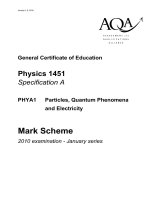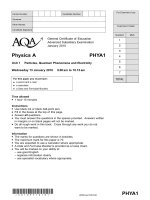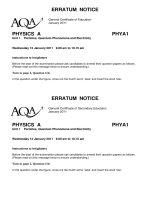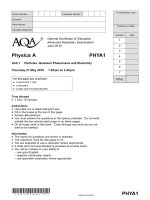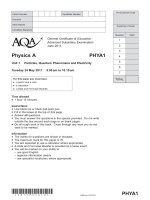- Trang chủ >>
- Khoa Học Tự Nhiên >>
- Vật lý
Vật lý A level: AQA PHYA5 2 d w QP JUN10
Bạn đang xem bản rút gọn của tài liệu. Xem và tải ngay bản đầy đủ của tài liệu tại đây (69.17 KB, 12 trang )
(JUN10PHYA52D01)
WMP/Jun10/PHYA5/2D
PHYA5/2D
Centre Number
Surname
Other Names
Candidate Signature
Candidate Number
General Certificate of Education
Advanced Level Examination
June 2010
Time allowed
●
The total time for both sections of this paper is 1 hour 45 minutes.
You are advised to spend approximately 50 minutes on this section.
Instructions
●
Use black ink or black ball-point pen.
●
Fill in the boxes at the top of this page.
●
Answer all questions.
●
You must answer the questions in the spaces provided. Do not write
outside the box around each page or on blank pages.
●
Do all rough work in this book. Cross through any work you do not
want to be marked.
Information
●
The marks for questions are shown in brackets.
●
The maximum mark for this section is 35.
●
You are expected to use a calculator where appropriate.
●
A Data and Formulae Booklet is provided as a loose insert.
●
You will be marked on your ability to:
– use good English
– organise information clearly
– use specialist vocabulary where appropriate.
For this paper you must have:
●
a calculator
●
a ruler
●
a Data and Formulae Booklet.
Physics A PHYA5/2D
Unit 5D Turning Points in Physics
Section B
Tuesday 29 June 2010 1.30 pm to 3.15 pm
MarkQuestion
For Examiner’s Use
Examiner’s Initials
TOTAL
1
2
3
4
WMP/Jun10/PHYA5/2D
Do not write
outside the
box
Section B
The maximum mark for this section is 35 marks. You are advised to spend approximately
50 minutes on this section.
1 A narrow beam of electrons is produced in a vacuum tube using an electron gun, part of
which is shown in Figure 1.
Figure 1
1 (a) (i) State and explain the effect on the beam of electrons of increasing the filament current.
(2 marks)
1 (a) (ii) State and explain the effect on the beam of electrons of increasing the anode potential.
(2 marks)
(02)
2
beam of electrons
anodecathode
filament
WMP/Jun10/PHYA5/2D
Tur n over
ᮣ
(03)
Do not write
outside the
box
1 (b) The beam of electrons is directed at right angles into a uniform magnetic field as shown
in Figure 2.
Figure 2
1 (b) (i) Explain why the electrons move in a circular path at a constant speed in the magnetic
field.
(3 marks)
Question 1 continues on the next page
3
electron beam
uniform magnetic field
perpendicular and
into the plane of
the diagram
WMP/Jun10/PHYA5/2D
Do not write
outside the
box
1 (b) (ii) When the speed of the electrons in the beam is 7.4 × 10
6
ms
–1
and the magnetic flux
density is 0.60 mT, the radius of curvature of the beam is 68 mm.
Use these data to calculate the specific charge of the electron, stating an appropriate
unit. Give your answer to an appropriate number of significant figures.
answer =
(4 marks)
1 (b) (iii) Discuss the historical relevance of the value of the specific charge of the electron
compared with the specific charge of the H
+
ion.
(2 marks)
4
(04)
13
WMP/Jun10/PHYA5/2D
Tur n over
ᮣ
(05)
Do not write
outside the
box
5
There are no questions printed on this page
DO NOT WRITE ON THIS PAGE
ANSWER IN THE SPACES PROVIDED
WMP/Jun10/PHYA5/2D
Do not write
outside the
box
2 When light of wavelength 590 nm is directed at an uncharged surface of a certain
metal X, electrons are emitted from the metal surface causing a photoelectric current.
2 (a) When the metal surface is charged positively, the photoelectric current decreases and
becomes zero when the potential of the surface is + 0.35 V.
2 (a) (i) Calculate the maximum kinetic energy of a photoelectron emitted from the surface
when the metal surface is uncharged.
answer = J
(2 marks)
2 (a) (ii) Calculate the work function of the metal surface, in J.
answer = J
(3 marks)
6
(06)
WMP/Jun10/PHYA5/2D
(07)
Do not write
outside the
box
2 (b) When the experiment was repeated using a different metal, Y, illuminated by light of the
same wavelength, there was no photoelectric emission when the metal surface was
uncharged.
2 (b) (i) Explain this observation.
(2 marks)
2 (b) (ii) How did this observation contribute to the failure of the wave theory of light?
(2 marks)
Turn over for the next question
7
Tur n over
ᮣ
9
WMP/Jun10/PHYA5/2D
Do not write
outside the
box
3 Figure 3 shows the probe of a scanning tunnelling microscope (STM) above a metal
surface.
Figure 3
3 (a) Explain why electrons can cross the gap between the tip of the probe and the surface,
provided
•
the gap is sufficiently narrow
•
a potential difference is applied between the tip and the surface.
The quality of your written communication will be assessed in this question.
(6 marks)
8
(08)
probe
metal surface
WMP/Jun10/PHYA5/2D
Do not write
outside the
box
3 (b) The probe is moved horizontally in a straight line across the surface. As it moves, the
current due to the transfer of electrons between the surface and the probe decreases then
returns to its initial value at the end of the line, as shown in Figure 4.
Figure 4
Explain why the current changes in this way.
(2 marks)
Turn over for the next question
9
Tur n over
ᮣ
(09)
8
0
distance moved
current
0
WMP/Jun10/PHYA5/2D
Do not write
outside the
box
4 (a) One of the two postulates of Einstein’s theory of special relativity is that the speed of
light in free space, c, is invariant.
Explain what is meant by this statement.
(1 mark)
4 (b) A beam of identical particles moving at a speed of 0.98c is directed along a straight line
between two detectors 25 m apart.
Figure 5
The particles are unstable and the intensity of the beam at the second detector is a
quarter of the intensity at the first detector.
Calculate the half-life of the particles in their rest frame.
answer = s
(4 marks)
END OF QUESTIONS
10
(10)
5
first
detector
beam of particles
second
detector
25 m
WMP/Jun10/PHYA5/2D
(11)
Do not write
outside the
box
11
There are no questions printed on this page
DO NOT WRITE ON THIS PAGE
ANSWER IN THE SPACES PROVIDED
WMP/Jun10/PHYA5/2D
(12)
Do not write
outside the
box
12
There are no questions printed on this page
DO NOT WRITE ON THIS PAGE
ANSWER IN THE SPACES PROVIDED
Copyright © 2010 AQA and its licensors. All rights reserved.

